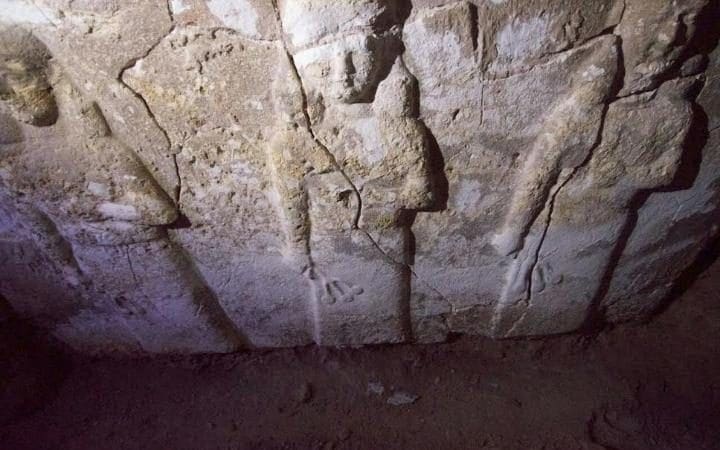Can militants associated with the so-called Islamic State be given credit for anything good?
Not one thing, most of us would say. Still, their misguided and destructive campaign to blot out priceless monuments from antiquity because they were associated with the worship of other gods — though centuries before Mohammed ever had visions of Allah — has led to a surprising discovery.
After sweeping into power in Mosul in 2014, the jihadists vented their vitriol by blowing up a mosque built around the famed “Tomb of the Prophet Jonah” (Nebi Yunus) in eastern Mosul. The mound is one of two known to comprise the site of ancient Nineveh, a long-running capital of Assyria. In addition to blowing up the mosque and tomb — which could not possibly have belonged to Jonah — the plunder-seeking outlaws also tunneled into the mound beneath the tomb in search of ancient artifacts they could steal and sell to unscrupulous buyers on the black market.

A carving of protective spirits found beneath Nebi Yunus. Photo credit Jérémy André, from telegraph.co.uk.
Archaeologists have long known that other and older ruins lay beneath Nebi Yunus. Earlier excavations had begun years ago, but were often interrupted and had not yet reached the 7th century BCE palace that Assyrian records say was built for Sennacherib (705-681BCE), expanded by Esarhaddon (681-669), and later renovated by Ashurbanipal (669-627) before being partially destroyed by the Babylonians in 612.
After Iraqi troops drove out the insurgents and retook parts of eastern Mosul last month, local archaeologists informed reporters for The Telegraph, a British newspaper, about the tunnels — and what they found when they investigated them.
While the looters no doubt hauled away hundreds of portable artifacts, they left in place large wall panels, including a massive marble cuneiform inscription and a relief sculpture of divine figures using plant fronds to sprinkle the “water of life,” presumably for the benefit of the king or other humans.

The wall at right contains a large cuneiform inscription from the time of Esarhaddon, 7th century BCE. Photo credit Jérémy André, from telegraph.co.uk.
The cuneiform text has yet to be studied in full, but appears to describe events from the reign of Esarhaddon. Archaeologists are currently documenting what they can on an emergency basis before the hastily dug tunnels cave in. A full excavation will require a more stable political and economic environment.
While it’s tempting to speak of the pilfering extremists’ actions as providing an unintended boon to archaeologists, we cannot speak kindly of the damage they caused, and can only wonder at what treasures they hauled away. Even if some artifacts are recovered, their original context has been lost and we can learn far less from them.
The episode does remind us, however, of how much lies beneath the ground, waiting to be discovered in careful and authorized excavations. Archaeology is not just about digging up dusty objects: what we learn from the past can inform our future. These recent events also reinforce the importance of working for peace that not only allows the important study of peoples who have gone before, but celebrates the lives of those who remain.



